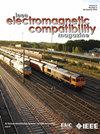空气-土壤界面附近的真实土壤回击场
IF 2.5
3区 计算机科学
Q3 ENGINEERING, ELECTRICAL & ELECTRONIC
IEEE Transactions on Electromagnetic Compatibility
Pub Date : 2025-04-07
DOI:10.1109/TEMC.2025.3554241
引用次数: 0
摘要
云对地雷击产生的回波场是防护工程中关注的重点。这个磁场不仅影响地面上和地面上的电力系统,而且还影响土壤中埋设的电缆和其他敏感设备。在文献中,领域在空气中由于回击已被彻底调查。然而,对土壤中反冲程场的评价相对较少。土壤中电场的测量很难找到,而大多数理论方法采用过于简化的土壤模型和广义的回冲程模型,这些模型没有考虑土壤参数对电流演化的影响。然而,最近的研究表明,土壤的电参数会显著影响回冲程的演化。鉴于此,我们认为有必要研究土壤电参数在空气和土壤中对回冲场的作用,并建立一个现实的土壤模型,包括土壤电离和频率相关的土壤参数。这项工作主要集中在距离通道500米径向距离内的回冲程产生的电场上。本文章由计算机程序翻译,如有差异,请以英文原文为准。
Return-Stroke Field Near the Air–Soil Interface With Realistic Soil
The return-stroke field generated by cloud-to-ground lightning is of primary concern in protection engineering. This field affects not only the electrical systems on and above the ground but also buried cables and other sensitive devices in the soil. In the literature, the field in the air due to return stroke has been thoroughly investigated. However, the assessment of the return-stroke field in the soil is relatively scarce. Measurement of the field in the soil is difficult to find, whereas most theoretical methods adopt oversimplified soil models and generalized return-stroke models, which do not consider any effect of soil parameters on current evolution. However, recent work has shown that soil's electrical parameters can significantly affect the return-stroke evolution. In light of this, it was deemed necessary to investigate the role of soil's electrical parameters on the return-stroke field, both in the air and the soil, with a realistic soil model, including soil ionization and frequency-dependent soil parameters. This work primarily focuses on the electric field produced by the return stroke within a radial distance of 500 m from the channel.
求助全文
通过发布文献求助,成功后即可免费获取论文全文。
去求助
来源期刊
CiteScore
4.80
自引率
19.00%
发文量
235
审稿时长
2.3 months
期刊介绍:
IEEE Transactions on Electromagnetic Compatibility publishes original and significant contributions related to all disciplines of electromagnetic compatibility (EMC) and relevant methods to predict, assess and prevent electromagnetic interference (EMI) and increase device/product immunity. The scope of the publication includes, but is not limited to Electromagnetic Environments; Interference Control; EMC and EMI Modeling; High Power Electromagnetics; EMC Standards, Methods of EMC Measurements; Computational Electromagnetics and Signal and Power Integrity, as applied or directly related to Electromagnetic Compatibility problems; Transmission Lines; Electrostatic Discharge and Lightning Effects; EMC in Wireless and Optical Technologies; EMC in Printed Circuit Board and System Design.

 求助内容:
求助内容: 应助结果提醒方式:
应助结果提醒方式:


